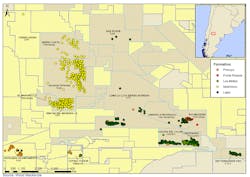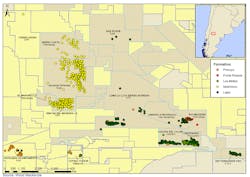WoodMac: Tight gas output triples in Argentina’s Neuquen basin, but costs still vary
A large shift to tight gas production in Argentina’s Neuquen basin is being driven by pricing incentives and lower costs vs. shale gas wells. However, at current costs, only the best tight gas wells break even at the incentivized $7.50/MMbtu gas price, according to analysis from research and consultancy firm Wood Mackenzie Ltd.
Tight gas production from the basin almost tripled over a 2-year period to 565 MMcfd during the first quarter, representing one quarter of the basin’s overall output, WoodMac notes, but well performance has been variable across all formations. Of the six tight gas formations studied, the median well in the Neuquen basin has a 90-day initial production (IP) rate of 2 MMcfd, with top quartile wells performing about five times higher than the bottom quartile.
Horizontal wells targeting the Mulichinco formation show the highest estimated ultimate recovery (EUR) at more than 5 bcf. The best wells in Punta Rosada are expected to achieve similar results with a vertical construction. Representative wells in the Lajas formation, meanwhile, are expected to recover a third of that volume.
“The large variability indicates that tight gas in Neuquen will continue to require a statistical development approach,” said Horacio Cuenca, WoodMac director of Latin America upstream research. “This means that large, multiwell development programs will be used to spread the productivity risk among a large number of wells. This approach is more similar to shale than to conventional developments.”
High costs, high output
WoodMac notes that longer laterals, more fracture stages, and increased water and propant usage are all factors that have been shown to enhance production but also increase well cost. Different sections of the same play also require unique considerations given variance in rock quality and thickness, pressure, and temperature.
“What is critically important is the relationship between the cost of these wells and the productivity they can achieve,” said Cuenca. “Our analysis shows that the tight gas wells with the highest costs also have the highest EURs and IP rates.”
Using type-well EURs and WoodMac’s current well-cost estimates, Mulichinco horizontal wells and Punta Rosada vertical wells, the most expensive in the basin on average, are profitable at or below the government’s $7.50/MMbtu incentivized gas price. These costs reflect a 15% reduction versus 2015 levels driven by the strong peso devaluation at the beginning of 2016. However, considerable additional reductions are still needed for type wells in these and other formations to be economic at the $5.20/MMbtu average gas price without incentives.
“Beyond discovering and focusing on the best producing sweet spots in each formation, enhancing EURs through more expensive wells—i.e. horizontal sections or targeting deep, thick formations with a high number of frac stages—seems a more plausible path for improving tight gas well economics in the short term rather than the drastic costs reductions needed with current EURs,” said Cuenca.
Capital efficiencies on IP rates in the Neuquen basin ranged $9,340-20,000/boe/d while EUR capital efficiencies ranged $13.70-29/boe. In comparison, WoodMac’s recently estimated capital efficiencies for unconventional wells within the Karnes Trough and Edwards Condensate subplays of the south Texas Eagle Ford shale showed capital efficiencies on IP rates ranging $8,000-15,000/boe/d and EUR capital efficiencies ranging $16-31/boe.

